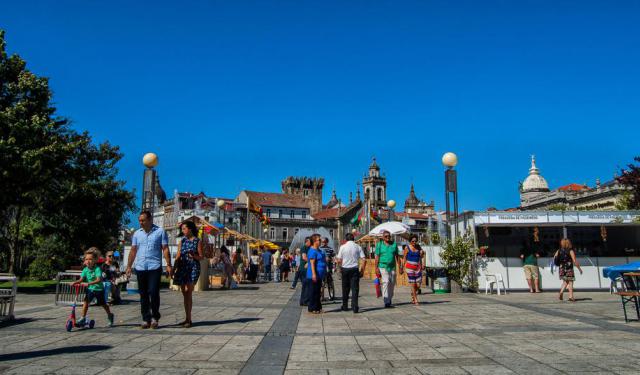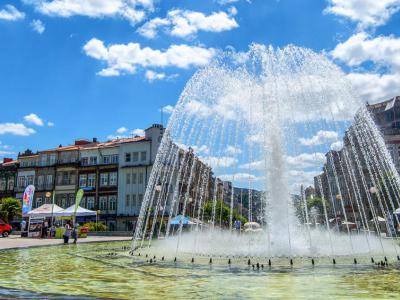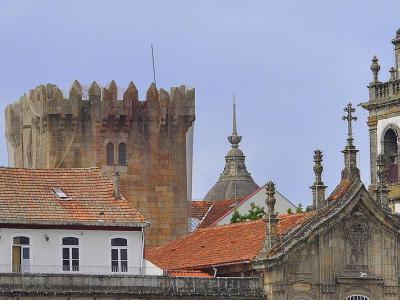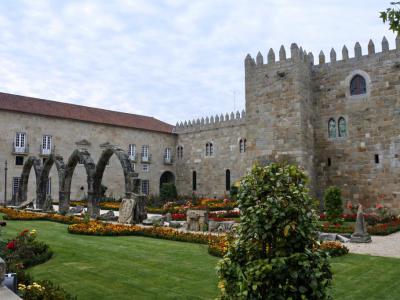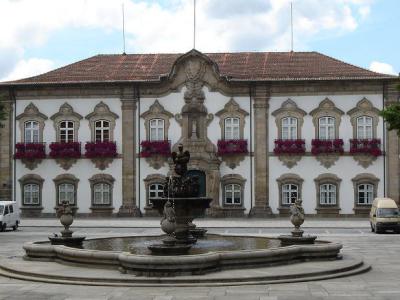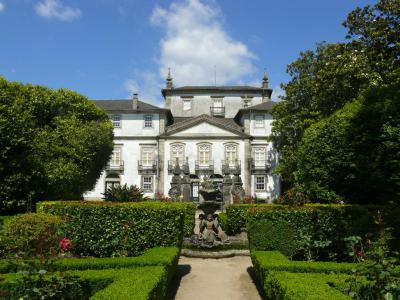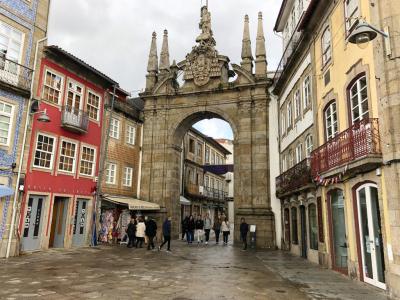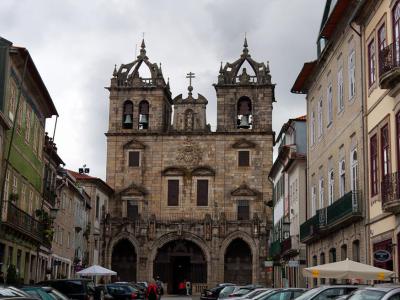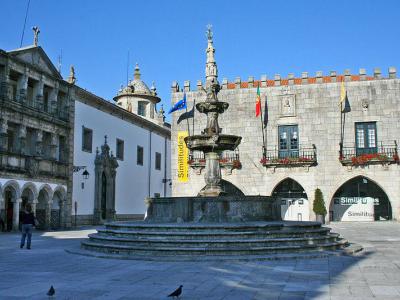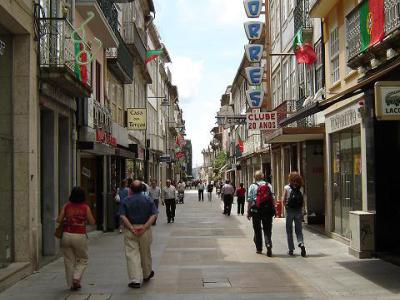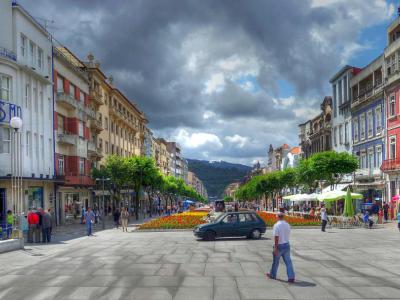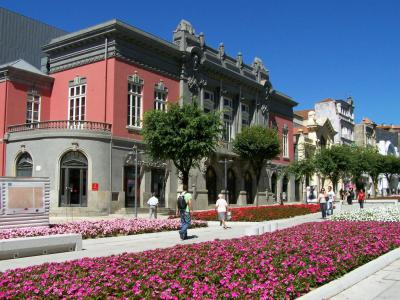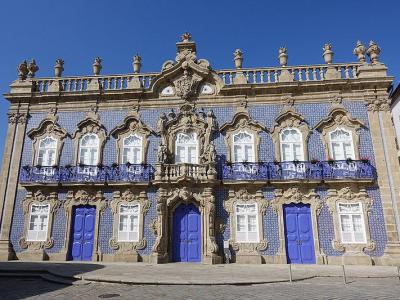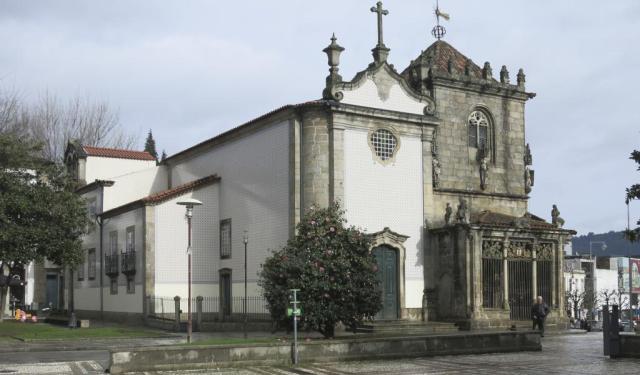Braga Introduction Walking Tour (Self Guided), Braga
The history of Braga, Portugal's religious capital, spans millennia. Located in the northern Minho region, this city is also one of the country's oldest, reportedly founded by Bracari Celts.
Braga's origin is closely associated with the Roman conquest in 136 BC, culminating in the establishment of Bracara Augusta in 16 BC, a pivotal location within the newly-formed Gallaecia province. The name of the city originated from the Celtic word "bracara," meaning "a place surrounded by mountains". Over centuries, Braga endured invasions and witnessed the Christianization of the Iberian Peninsula.
In the medieval era, the city played a crucial role in Portugal's emergence as an independent kingdom, solidifying its ecclesiastical and political significance. In the 12th century, Braga became the seat of Portugal's archbishops. The 16th century brought Renaissance transformations under Archbishop Diogo de Sousa, while the 18th century saw a Baroque revival led by architects like André Soares and Carlos Amarante.
The city's historical importance was reaffirmed during the Peninsular Wars of 1807–1814, and in the late 19th century, Portuguese immigrants from Brazil spurred growth and development. However, this period also saw the demolition of the Castle of Braga in 1905, a decision met with controversy and the subsequent establishment of the Dom Diogo de Sousa Regional Museum of Archaeology in 1918.
In the 20th century, Braga grappled with urban challenges brought about by demographic shifts and migration. Today, Braga remains a captivating blend of ancient heritage and modern dynamism, inviting visitors to explore its rich past and vibrant present.
One of the first stops on your journey through Braga is the Republic Square (Praca da Republica). Here, you can admire the elegant architecture, enjoy a cup of coffee at one of the charming cafes, and immerse yourself in the vibrant atmosphere.
Santa Barbara Garden (Jardim de Santa Barbara) is a serene oasis in the heart of the city, offering respite with its lush greenery and beautiful fountains.
Pious and brooding, Braga's ecclesiastical clout is underpinned by a rich collection of churches, earning the city its nickname, the "Portuguese Rome." Se de Braga, or Braga Cathedral, is a magnificent temple attesting to that.
The old town of Braga features a wealth of splendid 18th-century mansions fashioned out of granite in an imposing architectural style. Some of these noble buildings house excellent museums that further enhance the sightseeing experience. To enjoy firsthand all of this and more, we invite you on a self-guided journey to this enchanting Portuguese gem. Your adventure awaits!
Braga's origin is closely associated with the Roman conquest in 136 BC, culminating in the establishment of Bracara Augusta in 16 BC, a pivotal location within the newly-formed Gallaecia province. The name of the city originated from the Celtic word "bracara," meaning "a place surrounded by mountains". Over centuries, Braga endured invasions and witnessed the Christianization of the Iberian Peninsula.
In the medieval era, the city played a crucial role in Portugal's emergence as an independent kingdom, solidifying its ecclesiastical and political significance. In the 12th century, Braga became the seat of Portugal's archbishops. The 16th century brought Renaissance transformations under Archbishop Diogo de Sousa, while the 18th century saw a Baroque revival led by architects like André Soares and Carlos Amarante.
The city's historical importance was reaffirmed during the Peninsular Wars of 1807–1814, and in the late 19th century, Portuguese immigrants from Brazil spurred growth and development. However, this period also saw the demolition of the Castle of Braga in 1905, a decision met with controversy and the subsequent establishment of the Dom Diogo de Sousa Regional Museum of Archaeology in 1918.
In the 20th century, Braga grappled with urban challenges brought about by demographic shifts and migration. Today, Braga remains a captivating blend of ancient heritage and modern dynamism, inviting visitors to explore its rich past and vibrant present.
One of the first stops on your journey through Braga is the Republic Square (Praca da Republica). Here, you can admire the elegant architecture, enjoy a cup of coffee at one of the charming cafes, and immerse yourself in the vibrant atmosphere.
Santa Barbara Garden (Jardim de Santa Barbara) is a serene oasis in the heart of the city, offering respite with its lush greenery and beautiful fountains.
Pious and brooding, Braga's ecclesiastical clout is underpinned by a rich collection of churches, earning the city its nickname, the "Portuguese Rome." Se de Braga, or Braga Cathedral, is a magnificent temple attesting to that.
The old town of Braga features a wealth of splendid 18th-century mansions fashioned out of granite in an imposing architectural style. Some of these noble buildings house excellent museums that further enhance the sightseeing experience. To enjoy firsthand all of this and more, we invite you on a self-guided journey to this enchanting Portuguese gem. Your adventure awaits!
How it works: Download the app "GPSmyCity: Walks in 1K+ Cities" from Apple App Store or Google Play Store to your mobile phone or tablet. The app turns your mobile device into a personal tour guide and its built-in GPS navigation functions guide you from one tour stop to next. The app works offline, so no data plan is needed when traveling abroad.
Braga Introduction Walking Tour Map
Guide Name: Braga Introduction Walking Tour
Guide Location: Portugal » Braga (See other walking tours in Braga)
Guide Type: Self-guided Walking Tour (Sightseeing)
# of Attractions: 12
Tour Duration: 2 Hour(s)
Travel Distance: 2.0 Km or 1.2 Miles
Author: DanaOffice
Sight(s) Featured in This Guide:
Guide Location: Portugal » Braga (See other walking tours in Braga)
Guide Type: Self-guided Walking Tour (Sightseeing)
# of Attractions: 12
Tour Duration: 2 Hour(s)
Travel Distance: 2.0 Km or 1.2 Miles
Author: DanaOffice
Sight(s) Featured in This Guide:
- Praca da Republica (Republic Square)
- Castelo de Braga (Castle of Braga)
- Jardim de Santa Barbara (Santa Barbara Garden)
- Braga City Hall
- Museu dos Biscainhos (Biscainhos Museum)
- Arco da Porta Nova (Arch of the New Gate)
- Se de Braga (Braga Cathedral)
- Chafariz do Castelo (Castle Fountain)
- Rua do Souto (Souto Street)
- Avenida da Liberdade (Liberty Avenue)
- Theatro Circo (Circus Theater)
- Palacio do Raio (Raio Palace)
1) Praca da Republica (Republic Square)
The Republic Square has a history that dates back to the end of the Middle Ages. Its popular nickname, Arcada, comes from the arcade that graces the square. The arcade was constructed in 1715, following the initiative of D. Rodrigo de Moura Teles, replacing an earlier arcade that existed during the time of D. Diogo de Sousa. During the late 16th century, the Republic Square was a bustling hub for trade in foodstuffs, supplying the city with essential provisions.
In the mid-19th century, the Republic Square was transformed into a public garden. The current arcade building, designed by municipal engineer Joaquim Pereira da Cruz, was completed in 1885, adding to the square's architectural beauty.
The Republic Square is home to several noteworthy architectural landmarks. The Church of Lapa graces one corner of the square, while two iconic century-old cafés, Café Vianna and Astória, offer a taste of tradition and history. The Banco de Portugal building, constructed in 1921 by architect Moura Coutinho, occupies another section of the square. Adjacent to it stands a building once occupied by Banco do Minho, which was eventually demolished in the 1940s, making way for the current Caixa Geral de Depósitos building.
The square is surrounded by an array of cafes, restaurants, and shops, making it an ideal place for visitors to enjoy a meal, a coffee, or some shopping. You can savor traditional Portuguese cuisine, sip on coffee or wine, and explore local boutiques and souvenir stores in the vicinity.
In the mid-19th century, the Republic Square was transformed into a public garden. The current arcade building, designed by municipal engineer Joaquim Pereira da Cruz, was completed in 1885, adding to the square's architectural beauty.
The Republic Square is home to several noteworthy architectural landmarks. The Church of Lapa graces one corner of the square, while two iconic century-old cafés, Café Vianna and Astória, offer a taste of tradition and history. The Banco de Portugal building, constructed in 1921 by architect Moura Coutinho, occupies another section of the square. Adjacent to it stands a building once occupied by Banco do Minho, which was eventually demolished in the 1940s, making way for the current Caixa Geral de Depósitos building.
The square is surrounded by an array of cafes, restaurants, and shops, making it an ideal place for visitors to enjoy a meal, a coffee, or some shopping. You can savor traditional Portuguese cuisine, sip on coffee or wine, and explore local boutiques and souvenir stores in the vicinity.
2) Castelo de Braga (Castle of Braga)
The Keep is the only surviving part of Braga Castle, a once-mighty fortress. This granite structure reaches a height of thirty meters and offers a glimpse into the castle's former grandeur, which included five protective towers guarding the medieval walls.
In the early 14th century, King Dinis initiated a project to reconstruct and fortify Portugal's national defenses, which also included improvements in Braga. The reconstruction work in Braga is noteworthy for the royal coat of arms that still adorns the castle's north-eastern façade. However, construction in Braga was only completed in 1373 under the reign of King Fernando.
The medieval walls of Braga Castle featured five towers and eight gateways, of which some remnants remain to this day. Notable among them are the Tower of Porta Nova, the Gateway and Tower of Santiago, and the Tower of São Sebastião. However, the castle itself was demolished at the beginning of the 20th century and later served as a prison.
Today, the keep, which was once part of this medieval fortress, is no longer associated with its original military function. Instead, it is under the care of the Association for the Protection, Study, and Promotion of Cultural Heritage. While the castle's military significance has faded, the remaining structure serves as a valuable historical site, offering visitors a glimpse into Braga's rich past and architectural heritage.
In the early 14th century, King Dinis initiated a project to reconstruct and fortify Portugal's national defenses, which also included improvements in Braga. The reconstruction work in Braga is noteworthy for the royal coat of arms that still adorns the castle's north-eastern façade. However, construction in Braga was only completed in 1373 under the reign of King Fernando.
The medieval walls of Braga Castle featured five towers and eight gateways, of which some remnants remain to this day. Notable among them are the Tower of Porta Nova, the Gateway and Tower of Santiago, and the Tower of São Sebastião. However, the castle itself was demolished at the beginning of the 20th century and later served as a prison.
Today, the keep, which was once part of this medieval fortress, is no longer associated with its original military function. Instead, it is under the care of the Association for the Protection, Study, and Promotion of Cultural Heritage. While the castle's military significance has faded, the remaining structure serves as a valuable historical site, offering visitors a glimpse into Braga's rich past and architectural heritage.
3) Jardim de Santa Barbara (Santa Barbara Garden) (must see)
Santa Barbara Garden seamlessly combines the principles of geometric design with the organic beauty of colorful flowers, lush vegetation, and the presence of lively birds. What sets this garden apart is its central location, breaking the monotony of cement and brick structures, making it a truly unique urban oasis.
The garden derives its name from the 17th-century fountain at its heart, crowned by a statue of Santa Bárbara. This statue has a fascinating history as it once graced the Convento dos Remédios. The garden's connection to a local pastry called Viúvas adds an intriguing layer of cultural significance. It's believed that the Viúvas pastry was invented in the very convent where the fountain originally stood.
Nestled in the historic center of Braga, Santa Barbara Garden is a beloved gem recommended by locals and a photographer's dream. Its vibrant colors and meticulously tended flowers create a visually stunning environment. Adding to its allure, the Medieval Wing of the Paço Episcopal Braga provides a historical backdrop, imbuing the garden with a sense of timelessness and making it an even more extraordinary place to explore and savor.
The garden derives its name from the 17th-century fountain at its heart, crowned by a statue of Santa Bárbara. This statue has a fascinating history as it once graced the Convento dos Remédios. The garden's connection to a local pastry called Viúvas adds an intriguing layer of cultural significance. It's believed that the Viúvas pastry was invented in the very convent where the fountain originally stood.
Nestled in the historic center of Braga, Santa Barbara Garden is a beloved gem recommended by locals and a photographer's dream. Its vibrant colors and meticulously tended flowers create a visually stunning environment. Adding to its allure, the Medieval Wing of the Paço Episcopal Braga provides a historical backdrop, imbuing the garden with a sense of timelessness and making it an even more extraordinary place to explore and savor.
4) Braga City Hall
Braga City Hall, gracing the Municipal Square, is among the many splendid 18th-century buildings that adorn Braga.
The illustrious architect André Soares, born in Braga in 1720, is credited with the design of Braga City Hall. Soares left an indelible mark on the city with several remarkable creations, including the stunning Mosteiro de Tibães, the iconic Arco Da Porta Nova, the elegant Palácio do Raio, and the captivating Igreja dos Congregados. His architectural talents extended beyond Braga, as evidenced by his design of the Church of Nosso Senhor dos Santos Passos in the nearby city of Guimarães.
Construction of Braga's City Hall commenced in 1754 under Soares' visionary guidance, but it was not completed until 1865, long after the architect's passing. The City Hall's façade bears the distinctive hallmarks of Soares' architectural style. Emphasizing the central section, it features a prominent "door-niche-pediment" flanked by sturdy pillars. Although the elements are treated with a more linear and voluptuous approach, Soares' unique architectural essence remains palpable in this splendid structure.
The illustrious architect André Soares, born in Braga in 1720, is credited with the design of Braga City Hall. Soares left an indelible mark on the city with several remarkable creations, including the stunning Mosteiro de Tibães, the iconic Arco Da Porta Nova, the elegant Palácio do Raio, and the captivating Igreja dos Congregados. His architectural talents extended beyond Braga, as evidenced by his design of the Church of Nosso Senhor dos Santos Passos in the nearby city of Guimarães.
Construction of Braga's City Hall commenced in 1754 under Soares' visionary guidance, but it was not completed until 1865, long after the architect's passing. The City Hall's façade bears the distinctive hallmarks of Soares' architectural style. Emphasizing the central section, it features a prominent "door-niche-pediment" flanked by sturdy pillars. Although the elements are treated with a more linear and voluptuous approach, Soares' unique architectural essence remains palpable in this splendid structure.
5) Museu dos Biscainhos (Biscainhos Museum)
The Biscainhos Museum offers a captivating journey into the past within the splendid setting of a 17th-century residential palace. The palace itself stands as a stunning example of civil Baroque architecture, impeccably preserving the original state of the various buildings and providing a tangible connection to the past. As visitors step inside, they are greeted by an extensive exhibition showcasing art from the 17th and 18th centuries. The collection is primarily comprised of private donations, featuring an exquisite array of Baroque furniture, ceramics, Chinese porcelain, European glasswork, silverware, textiles, as well as Portuguese and European paintings.
Exploring the palace is a visual feast, with its polychrome, chestnut-panelled ceilings and 18th-century azulejos (tiles) that depict captivating hunting scenes. The ground floor, paved with deeply ribbed flagstones, harks back to a time when carriages would have clattered through en route to the stables.
Beyond the palace, the museum boasts gorgeously landscaped gardens that are a testament to the refined tastes of the 18th century, inspired by French styles of the era. These gardens are among the best-preserved and most complete examples of the Baroque period, offering a tranquil and picturesque outdoor space that complements the grandeur of the palace.
Exploring the palace is a visual feast, with its polychrome, chestnut-panelled ceilings and 18th-century azulejos (tiles) that depict captivating hunting scenes. The ground floor, paved with deeply ribbed flagstones, harks back to a time when carriages would have clattered through en route to the stables.
Beyond the palace, the museum boasts gorgeously landscaped gardens that are a testament to the refined tastes of the 18th century, inspired by French styles of the era. These gardens are among the best-preserved and most complete examples of the Baroque period, offering a tranquil and picturesque outdoor space that complements the grandeur of the palace.
6) Arco da Porta Nova (Arch of the New Gate)
The Arch of the New Gate is a magnificent ornamental gateway that serves as an entrance to the historic center of Braga from the western side. This architectural gem, located on the pedestrianized Rua do D. Diogo de Sousa, is not only a functional passageway but also a striking piece of art and history.
The history of the arch traces back to the late 1300s when a gate was first erected on this spot as part of the city's defensive walls. However, the Arco da Porta Nova in its present form was designed by the renowned architect André Soares in the 1770s. The western face of the Arco da Porta Nova is characterized by the opulent Baroque style for which Soares became famous. It features intricate details and ornate decorations that are characteristic of the Baroque period. On this side, one can admire the allegorical figure of Braga, a tribute to the city's identity and history.
In contrast, the eastern side of the arch adopts a neoclassical design, showcasing the versatility and adaptability of André Soares' architectural vision. Here, a statue of the Virgin Mary graces the arch, adding a touch of spirituality and grace to the structure.
As you pass through this remarkable gateway, you'll find yourself on Rua Dom Diogo de Sousa, a charming pedestrianized street that leads to Braga's Cathedral and the Igreja Misericórdia. Along this lively street, you'll discover an array of popular bars, restaurants, and shops, many of which offer outdoor seating during the summer months.
The history of the arch traces back to the late 1300s when a gate was first erected on this spot as part of the city's defensive walls. However, the Arco da Porta Nova in its present form was designed by the renowned architect André Soares in the 1770s. The western face of the Arco da Porta Nova is characterized by the opulent Baroque style for which Soares became famous. It features intricate details and ornate decorations that are characteristic of the Baroque period. On this side, one can admire the allegorical figure of Braga, a tribute to the city's identity and history.
In contrast, the eastern side of the arch adopts a neoclassical design, showcasing the versatility and adaptability of André Soares' architectural vision. Here, a statue of the Virgin Mary graces the arch, adding a touch of spirituality and grace to the structure.
As you pass through this remarkable gateway, you'll find yourself on Rua Dom Diogo de Sousa, a charming pedestrianized street that leads to Braga's Cathedral and the Igreja Misericórdia. Along this lively street, you'll discover an array of popular bars, restaurants, and shops, many of which offer outdoor seating during the summer months.
7) Se de Braga (Braga Cathedral) (must see)
The Sé de Braga showcases a blend of architectural styles that reflect the cathedral's long and varied history. While its origins date back to the 11th century, subsequent renovations and additions have contributed to its unique appearance.
The original structure of the Sé de Braga was primarily Romanesque, characterized by its robust, fortress-like design. Visitors can admire the Romanesque façade with its intricate sculptural details, including biblical scenes and figures.
In the 14th century, significant Gothic renovations were carried out on the cathedral, contributing to its soaring pointed arches, ribbed vaults, and large stained glass windows. These Gothic elements add to the grandeur and grace of the cathedral's interior.
The interior of the Sé de Braga also features Baroque elements, including ornate altarpieces, gilded woodwork, and decorative motifs. The Baroque Chapel of the Kings (Capela dos Reis) is a notable highlight, adorned with beautifully crafted sculptures and intricate decorations.
The Sé de Braga boasts a unique Manueline-style chapel, characterized by its maritime-inspired details, such as ropes, shells, and seaweed motifs.
The cathedral also features a stunning cloister, built in the 14th century. This peaceful courtyard is adorned with Gothic and Manueline elements and provides visitors with an opportunity to appreciate the intricate craftsmanship of the period.
The Sé de Braga remains an active place of worship and is a significant pilgrimage site for Catholics in Portugal. Today, the Sé de Braga welcomes visitors who can explore its historic interior, marvel at its architectural features, and soak in the atmosphere of this sacred place.
The original structure of the Sé de Braga was primarily Romanesque, characterized by its robust, fortress-like design. Visitors can admire the Romanesque façade with its intricate sculptural details, including biblical scenes and figures.
In the 14th century, significant Gothic renovations were carried out on the cathedral, contributing to its soaring pointed arches, ribbed vaults, and large stained glass windows. These Gothic elements add to the grandeur and grace of the cathedral's interior.
The interior of the Sé de Braga also features Baroque elements, including ornate altarpieces, gilded woodwork, and decorative motifs. The Baroque Chapel of the Kings (Capela dos Reis) is a notable highlight, adorned with beautifully crafted sculptures and intricate decorations.
The Sé de Braga boasts a unique Manueline-style chapel, characterized by its maritime-inspired details, such as ropes, shells, and seaweed motifs.
The cathedral also features a stunning cloister, built in the 14th century. This peaceful courtyard is adorned with Gothic and Manueline elements and provides visitors with an opportunity to appreciate the intricate craftsmanship of the period.
The Sé de Braga remains an active place of worship and is a significant pilgrimage site for Catholics in Portugal. Today, the Sé de Braga welcomes visitors who can explore its historic interior, marvel at its architectural features, and soak in the atmosphere of this sacred place.
8) Chafariz do Castelo (Castle Fountain)
Dating back to the year 1723, the Castle Fountain is a testament to the city's rich heritage and architectural finesse. The fountain is renowned for its intricate and decorative design. It reflects the Baroque style prevalent during the 18th century, characterized by its exuberant ornamentation and attention to detail. The crowning feature of the fountain is a feminine figure positioned at the top. This figure is considered a symbolic representation of the city of Braga.
The fountain owes its existence to Rodrigo de Moura Teles (1644-1728), an archbishop of Braga. It was commissioned by him and stands as a testament to his architectural patronage. Moura Teles played a significant role in the cultural and architectural development of the city during his time.
The Castle Fountain gets its name from the unique design of its spouts. Each of the six spouts resembles a castle, lending a distinctive character to the fountain. Beneath the castle-shaped spouts, the fountain is adorned with classical putti figures. These cherubic sculptures are depicted as holding up the spouts, showcasing the craftsmanship and artistry of the period. At the very top of the fountain's pinnacle, above the feminine figure, you can find an iron armillary sphere. This celestial globe, along with a patriarchal cross, adds further symbolism and religious elements to the fountain's design.
The Castle Fountain shares ithe square with the Archbishop's Palace, the rectory building of the University of Minho (Universidade do Minho), and the Braga Public Library and Municipal Archive. This setting enhances the overall historical and cultural ambiance of the fountain's location.
The fountain owes its existence to Rodrigo de Moura Teles (1644-1728), an archbishop of Braga. It was commissioned by him and stands as a testament to his architectural patronage. Moura Teles played a significant role in the cultural and architectural development of the city during his time.
The Castle Fountain gets its name from the unique design of its spouts. Each of the six spouts resembles a castle, lending a distinctive character to the fountain. Beneath the castle-shaped spouts, the fountain is adorned with classical putti figures. These cherubic sculptures are depicted as holding up the spouts, showcasing the craftsmanship and artistry of the period. At the very top of the fountain's pinnacle, above the feminine figure, you can find an iron armillary sphere. This celestial globe, along with a patriarchal cross, adds further symbolism and religious elements to the fountain's design.
The Castle Fountain shares ithe square with the Archbishop's Palace, the rectory building of the University of Minho (Universidade do Minho), and the Braga Public Library and Municipal Archive. This setting enhances the overall historical and cultural ambiance of the fountain's location.
9) Rua do Souto (Souto Street)
The history of Rua do Souto dates back to 1466 when it was commissioned by Archbishop D. Diogo de Sousa. The street was designed to provide access to the old Braga Castle, which was part of the citadel. Sadly, the castle was destroyed in 1906. The chestnut trees that once lined this path were used in the construction of the vault of the Cathedral, emphasizing the street's historical connection to Braga's architectural heritage.
Over time, Rua do Souto became a prestigious area for both housing and commerce. Its strategic location, connecting the citadel to the city center, attracted merchants and noble families alike. As a result, many well-to-do residents and businesses established themselves along this picturesque street.
Today, Rua do Souto thrives as one of Braga's main shopping streets. It is known for its diverse range of shops and commercial establishments. Visitors can explore an array of offerings, including local and global fashion boutiques, wine bars, bookstores, drugstores, homeware stores, and even rare art shops. The street's commercial vitality has made it a popular destination for both residents and tourists seeking unique and diverse shopping experiences.
One of the defining features of Rua do Souto is its pedestrian-friendly layout. This design encourages leisurely walks, social interactions, and a relaxed shopping experience.
At approximately the midpoint of Rua do Souto, the street widens to form Largo da Paço square. This charming square serves as a gathering place and adds to the street's appeal.
Over time, Rua do Souto became a prestigious area for both housing and commerce. Its strategic location, connecting the citadel to the city center, attracted merchants and noble families alike. As a result, many well-to-do residents and businesses established themselves along this picturesque street.
Today, Rua do Souto thrives as one of Braga's main shopping streets. It is known for its diverse range of shops and commercial establishments. Visitors can explore an array of offerings, including local and global fashion boutiques, wine bars, bookstores, drugstores, homeware stores, and even rare art shops. The street's commercial vitality has made it a popular destination for both residents and tourists seeking unique and diverse shopping experiences.
One of the defining features of Rua do Souto is its pedestrian-friendly layout. This design encourages leisurely walks, social interactions, and a relaxed shopping experience.
At approximately the midpoint of Rua do Souto, the street widens to form Largo da Paço square. This charming square serves as a gathering place and adds to the street's appeal.
10) Avenida da Liberdade (Liberty Avenue)
The Liberty Avenue's history is intertwined with Braga's development over the years. As the city evolved, this avenue emerged as a symbol of progress and modernization.
One of the defining features of Liberty Avenue is its impressive architecture. The buildings lining the avenue showcase various architectural styles, including neoclassical and art deco, providing a visual feast for visitors. Many of these buildings house shops, offices, and cafes, contributing to the avenue's vibrant atmosphere.
Liberty Avenue is a bustling commercial hub in Braga. It is home to a diverse range of businesses, including fashion boutiques, jewelry stores, bookshops, and more. The avenue's shops cater to various tastes and preferences, making it a popular destination for shopping enthusiasts.
Throughout the avenue, visitors can find a multitude of cafes and restaurants where they can indulge in local and international cuisine. These establishments offer an opportunity to savor delicious food and beverages while enjoying the avenue's ambiance.
The avenue's design incorporates green spaces, trees, and well-maintained promenades. Braga's residents take pride in Avenida da Liberdade, considering it a symbol of their city's cultural and commercial vitality.
One of the defining features of Liberty Avenue is its impressive architecture. The buildings lining the avenue showcase various architectural styles, including neoclassical and art deco, providing a visual feast for visitors. Many of these buildings house shops, offices, and cafes, contributing to the avenue's vibrant atmosphere.
Liberty Avenue is a bustling commercial hub in Braga. It is home to a diverse range of businesses, including fashion boutiques, jewelry stores, bookshops, and more. The avenue's shops cater to various tastes and preferences, making it a popular destination for shopping enthusiasts.
Throughout the avenue, visitors can find a multitude of cafes and restaurants where they can indulge in local and international cuisine. These establishments offer an opportunity to savor delicious food and beverages while enjoying the avenue's ambiance.
The avenue's design incorporates green spaces, trees, and well-maintained promenades. Braga's residents take pride in Avenida da Liberdade, considering it a symbol of their city's cultural and commercial vitality.
11) Theatro Circo (Circus Theater)
Circus Theater is a historic Portuguese revivalist theater. Designed by the architect João de Moura Coutinho, it was officially inaugurated on April 21, 1915. Over the years, it has played a significant role in Braga's cultural scene, hosting a wide range of performances, including the first talking films, operas, and various public events.
The building's architecture is characterized by Portuguese revivalist style, reflecting a blend of traditional and eclectic elements. It is rectangular in layout and consists of two adjacent structures with staggered horizontal volumes, featuring tile-covered roofs. The facades are adorned with plasterwork and painted in rose colors, resting on a sturdy granite foundation. A prominent cornice and architrave in granite crown the building.
The main entrance of the theater is flanked by sections featuring three arched doorways, each surmounted by three rectangular windows with decorative motifs on the lintels. Inside, the central foyer is a magnificent space adorned with rose, white, and gold colors. It boasts marble columns, large glass doors, and a stucco-panel ceiling painted in white, rose, and gold. This area provides access to various lounges, a bar, dressing rooms, and seating areas on the first floor, accessible via a grand staircase with black marble steps and metal/wood handrails.
The interior of Theatro Circo is richly decorated, featuring columns, intricate wall decorations, ornate floors, and elaborately designed ceilings. The auditorium is a grand and impressive space characterized by its Neo-Baroque elements and the rhythmic organization of balconies, which are highly adorned.
The building's architecture is characterized by Portuguese revivalist style, reflecting a blend of traditional and eclectic elements. It is rectangular in layout and consists of two adjacent structures with staggered horizontal volumes, featuring tile-covered roofs. The facades are adorned with plasterwork and painted in rose colors, resting on a sturdy granite foundation. A prominent cornice and architrave in granite crown the building.
The main entrance of the theater is flanked by sections featuring three arched doorways, each surmounted by three rectangular windows with decorative motifs on the lintels. Inside, the central foyer is a magnificent space adorned with rose, white, and gold colors. It boasts marble columns, large glass doors, and a stucco-panel ceiling painted in white, rose, and gold. This area provides access to various lounges, a bar, dressing rooms, and seating areas on the first floor, accessible via a grand staircase with black marble steps and metal/wood handrails.
The interior of Theatro Circo is richly decorated, featuring columns, intricate wall decorations, ornate floors, and elaborately designed ceilings. The auditorium is a grand and impressive space characterized by its Neo-Baroque elements and the rhythmic organization of balconies, which are highly adorned.
12) Palacio do Raio (Raio Palace)
The Raio Palace stands as a splendid example of Baroque civil architecture and is associated with the renowned architect André Soares. The palace was constructed during the reign of King João V (1706-1750) and was commissioned by José Duarte de Faria, a prominent figure in Braga who held the title of a knight in the Order of Christ and was a highly influential trader.
The origins of the name can be traced back to 1834 when the property was acquired by Miguel José Raio, the Viscount of São Lázaro. It is believed that he bestowed the name upon the residence, giving it the moniker House or Palace of Raio.
The palace is distinguished by its remarkable architectural features and decorative elements. The façade is adorned with exquisite azulejo tiles, which were added in the 19th century. The banisters are intricately designed, featuring decorative flame effects and amphoras. The verandas are crafted from forged iron and finely worked granite, showcasing the skilled craftsmanship of the time.
Inside the palace, visitors can admire the noble staircase, which is a highlight of the interior. The staircase features three arches and a sculpture of a Turk, adding to the overall grandeur of the building. Notably, there are similarities between this sculpture and the four statues found in the esplanade of the Church of Bom Jesus. While the attribution of these sculptures to André Soares is debated, they remain significant pieces of art within the palace.
Raio Palace is considered one of André Soares' most important architectural achievements, reflecting the opulence and artistic richness of the Baroque era.
The origins of the name can be traced back to 1834 when the property was acquired by Miguel José Raio, the Viscount of São Lázaro. It is believed that he bestowed the name upon the residence, giving it the moniker House or Palace of Raio.
The palace is distinguished by its remarkable architectural features and decorative elements. The façade is adorned with exquisite azulejo tiles, which were added in the 19th century. The banisters are intricately designed, featuring decorative flame effects and amphoras. The verandas are crafted from forged iron and finely worked granite, showcasing the skilled craftsmanship of the time.
Inside the palace, visitors can admire the noble staircase, which is a highlight of the interior. The staircase features three arches and a sculpture of a Turk, adding to the overall grandeur of the building. Notably, there are similarities between this sculpture and the four statues found in the esplanade of the Church of Bom Jesus. While the attribution of these sculptures to André Soares is debated, they remain significant pieces of art within the palace.
Raio Palace is considered one of André Soares' most important architectural achievements, reflecting the opulence and artistic richness of the Baroque era.
Walking Tours in Braga, Portugal
Create Your Own Walk in Braga
Creating your own self-guided walk in Braga is easy and fun. Choose the city attractions that you want to see and a walk route map will be created just for you. You can even set your hotel as the start point of the walk.
Historical Religious Sites Walking Tour
Braga is a prominent destination in Portugal's Religious Tourism segment, primarily due to its vibrant Holy Week celebrations and rich ecclesiastical architecture. Indeed, being one of the world's oldest Christian cities, Braga boasts an extensive religious legacy. Much like Rome, it seamlessly interweaves art and spirituality throughout its historic center.
Here, you will find a... view more
Tour Duration: 1 Hour(s)
Travel Distance: 1.4 Km or 0.9 Miles
Here, you will find a... view more
Tour Duration: 1 Hour(s)
Travel Distance: 1.4 Km or 0.9 Miles
The Most Popular Cities
/ view all
